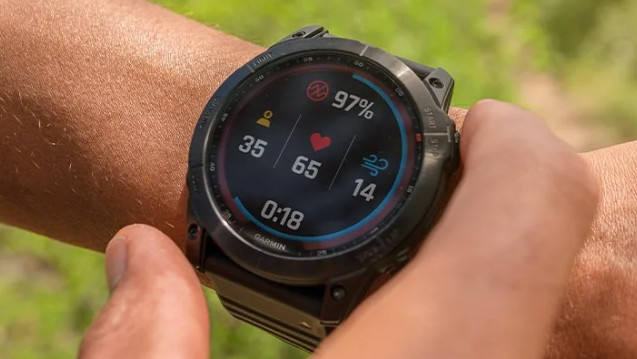
Garmin is working on a new watch that will measure blood oxygen saturation (SpO2) more accurately than ever. A recently published patent application reveals how the company is planning to use a new system to measure SpO2 levels from your wrist that could make the data much more accurate – and more useful.
Most of the best GPS watches can measure SpO2, and it can be very handy. Lower than normal SpO2 can indicate that you're not recovering well after a tough workout session, while sudden drops overnight can be an indication that you're suffering from a condition like sleep apnea and should book an appointment with your doctor. If you're engaged in altitude training, you should see your SpO2 increase as your body becomes acclimatized.
Watches measure SpO2 by shining two lights on your skin (red and infrared), then analyzing the properties of the light that's reflected back. Oxygenated and deoxygenated blood absorb different amounts of red and infrared, which means the watch's software can determine how much O2 your blood is carrying.
This method (known as reflective pulse oximetry) generally works well, but isn't the most accurate way to measure SpO2. The pulse oximeters used in hospitals clip onto your finger or ear, and are able to get a more accurate reading by shining light through tissue rather than relying on it bouncing back from your skin. Reflective pulse oximetry is also prone to 'noise' cased by movement or light leakage.
The newly listed patent (document ID US 20220142569 A1, which can be found through the US Patents and Trademarks Office) explains how Garmin is aiming to narrow the gap by introducing a third light.
How the new tech works
"Reflective peripheral pulse oximetry is convenient because reflective techniques can be employed at a surface of part of the body, such as the feet, forehead, chest, or wrist, in connection with a wearable device such as a smart watch," it states.
"Unfortunately, reflective peripheral pulse oximetry tends to provide unstable readings resulting in difficulty in taking accurate, predictable, and repeatable readings. Accordingly, there is a need for more accurate and reliable reflective peripheral pulse oximetry technology and for systems to determine an associated level of validity of SpO2 measurements."
All the latest inspiration, tips and guides to help you plan your next Advnture!
Instead of the conventional two-light setup, Garmin's proposed system would use one red light with a wavelength of approximately 630 nanometers (nm), one infrared light with a wavelength of approximately 940nm, and a second red light with a wavelength of around 660nm.
The watch will calculate two SpO2 values using the data from the infrared light and each of the red lights. It will use different calculations to allow for the different wavelengths, but in theory, the two results should be the same.
"Because valid measurements taken with light sources of differing wavelength should generate the same value for SpO2, if the calculated results are sufficiently close, there is a high certainty that the measured SpO2 is valid," the patent explains.
The patent was first registered with the US Patents and Trademarks Office in 2020, and there's no guarantee that three-wavelength pulse oximetry will appear in a finished product any time soon but it's nevertheless a very interesting technology that could make the biometrics from your watch much more accurate. We've got our fingers crossed.

Cat is the editor of Advnture, She’s been a journalist for 15 years, and was fitness and wellbeing editor on TechRadar before joining the Advnture team in 2022. She’s a UK Athletics qualified run leader, and in her spare time enjoys nothing more than lacing up her shoes and hitting the roads and trails (the muddier, the better), usually wearing at least two sports watches.
